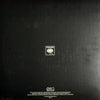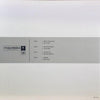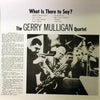







Gerry Mulligan Quartet - What Is There To Say? (2LP, 45RPM)
ORDER LIMITED TO ONE ITEM PER CUSTOMER
Baritone Saxophone – Gerry Mulligan [click here to see more vinyl featuring Gerry Mulligan]
Bass – Bill Crow [click here to see more products featuring Bill Crow]
Drums – Dave Bailey
Trumpet – Art Farmer [click here to see more vinyl featuring Art Farmer]
2 LPs, Deluxe Laminated Gatefold Jacket
Edition limited to 2,500 numbered copies
Original analog Master tape : YES
Heavy Press : 180g
Record color : Black
Speed : 45 RPM
Size : 12'’
Stereo
Studio
Record Press : RTI
Label : Original Recordings Group
Original Label : Verve
Recorded 17 December 1958 (D1); 23 December 1958 (C1-2, D2); 15 January 1959 (A1-2, B1-2)
Produced by Teo Macero
Mastered by Bernie Grundman
Originally released in 1959
Reissued in 2011
Tracks:
Side A:
- What Is There To Say
- Just In Time
Side B:
- News From Blueport
- Festive Minor
Side C:
- As Catch Can
- My Funny Valentine
Side D:
- Blueport
- Utter Chaos
Reviews:
"The album is sonically superior... Altogether a wonderful reissue cut by Bernie Grundman from either the master tape or a flat transfer of the master. Either way, great sound and ideal cocktail hour or late night "end of the day" music that's easy to recommend to both jazz aficionados and casual jazz enthusiasts alike. " Michael Fremer, Analog Planet
“mong those who know jazz, you'll hear endless debate over who is the greatest pianist or tenor saxophonist, especially as you break the music down into its categories -- swing, hard bop, avant-garde, etc. But there is little doubt that Gerry Mulligan was the greatest baritone sax player. He could hang musically with just about everyone, and his dexterous playing -- a byproduct of his early days as a pianist -- opened up musical opportunities for his imposing instrument. He recorded for every major jazz label throughout the entirety of the 1950s and 1960s, producing five-star dates for them all, and he made worthwhile recordings all the way into the 1980s.
What Is There to Say? was a date from 1959 that included Art Farmer on trumpet, Bill Crow on bass and Dave Bailey on drums. The session's lack of piano underpinning required that both Mulligan and Farmer carry rhythm and melody in equal measure. This is more cool than hard bop, Mulligan's and Farmer's inventions alternating between tight interplay and distinctive, personal soloing. There are some especially fine moments between the duo on two Mulligan originals, "Festive Minor" and "Utter Chaos," with the leader playing something closer to a backup role.
This is one of the better-sounding late-'50s Columbia sessions. While it still has the hard right-left stereo spread of so many jazz recordings from its time, with little happening in between the speakers, the horns' up-close perspective provides a sense of vividness. I have early stereo and mono originals and prefer the mono for its lack of stereo issues and greater tonal purity. The stereo Original Recordings Group reissue has two important technical advantages over either original pressing. The first is the faster playback speed, which makes for a less crowded groove and greater density of musical information. The horns sound both bigger and more complete, possessing a rounded fullness that neither original conveys, and the drums now anchor the center. The second advantage is the fact that the reissue was cut with the RIAA EQ curve instead of Columbia's house curve. Played back at RIAA, my original pressings are thin and grayish throughout and somewhat splashy in the treble, while the reissue sounds well balanced and complete -- simply better.
How much better? Well, no reissued CD, no SACD, will offer an equivalent level of improvement over an earlier version -- not even close, in fact. And while you can certainly change the sound with a different amp or speaker, you still won't retrieve the musically significant detail from the originals that this reissue makes plain.
Put another way, the ORG LPs cream my near-mint six-eye pressings, and there's nothing more to say than that.” Mark Mickelson, The Audio Beat
“The last of the pianoless quartet albums that Gerry Mulligan recorded in the 1950s is one of the best, featuring the complementary trumpet of Art Farmer, bassist Bill Crow, and drummer Dave Bailey along with the baritonist/leader. This recording is a little skimpy on playing time but makes every moment count. Virtually every selection is memorable, with "What Is There to Say," "Just in Time," "Festive Minor," "My Funny Valentine," and "Utter Chaos" being the high points. Highly recommended both to Mulligan collectors and to jazz listeners who are just discovering the great baritonist.” AllMusic Review by Scott Yanow
“What Is There To Say? is rightly considered one of Gerry Mulligan's best albums, which is quite a designation if you think about how many great LPs the dude put out over his long career. The piano-less quartet setting is perfect for the group on hand, which includes the criminally underrated Art Farmer on trumpet and the very talented Dave Bailey on drums.
As usual Mulligan's playing on the baritone is a revelation: the gentle flowing tone he gets from his instrument practically defines the cool jazz genre. What Is There To Say? firmly falls into that genre, with it's overall laid back vibe (particularly on the title track), although the group does get the chance to up the tempo on a few quality hard bop tracks.” The Jazz Record, May 2017
Ratings :
AllMusic : 5 / 5 , Discogs : 4.8 / 5 , Michael Fremer : 9/11 Music, 9/11 Sonics ;
Audio Beat : 4/5 Music, 4.5/5 Sound!


